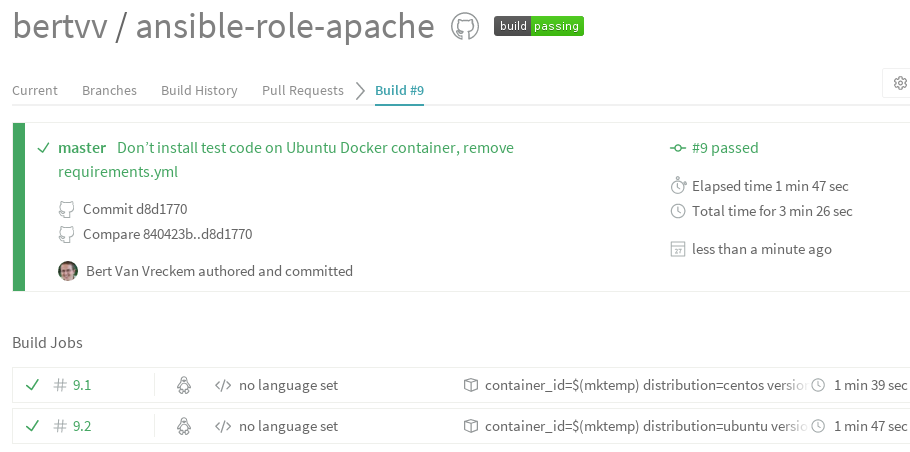Testing Ansible roles with Travis-CI, Part 2: Multi-platform tests
In the previous post on testing Ansible roles with Travis-CI, I introduced a method to run playbooks on CentOS using Docker. In this post, we take this one step further and show how you can run multi-platform tests of Ansible roles.
As a proof of concept, I’ll continue with the example of part one: Apache, the hello world of configuration management. My own Apache role was written only for EL/CentOS (for now), so it’s not suitable. Therefore I thought of giving Jeff Geerling’s Apache role a try. We’ll set up a test environment with two target platforms: Ubuntu and CentOS.
Setting up the Docker containers
The test code is structured as follows (relative to the root of the Git project):
.
├── tests
│ ├── Dockerfile.centos
│ ├── Dockerfile.ubuntu
│ └── test.yml
└── .travis.yml
The Dockerfile for CentOS is the same as in part one, so I won’t repeat it here. The one for the Ubuntu container follows below. It is a bit simpler because we don’t have to install systemd.
# Dockerfile.ubuntu
FROM ubuntu:14.04
# Install Ansible
RUN apt-get install -y software-properties-common git
RUN apt-add-repository -y ppa:ansible/ansible
RUN apt-get update
RUN apt-get install -y ansible
# Install Ansible inventory file
RUN echo "[local]\nlocalhost ansible_connection=local" > /etc/ansible/hosts
Running the tests
This is the test playbook:
# test.yml
---
- hosts: all
vars:
apache_listen_port_ssl: 443
apache_create_vhosts: true
apache_vhosts_filename: "vhosts.conf"
apache_vhosts:
- servername: "example.com"
documentroot: "/var/www/vhosts/example_com"
roles:
- role_under_testIt will be run on both the Ubuntu and the CentOS container. The .travis.yml file becomes:
# .travis.yml
---
sudo: required
env:
- >
container_id=$(mktemp)
distribution=centos
version=7
init=/usr/lib/systemd/systemd
run_opts="--privileged --volume=/sys/fs/cgroup:/sys/fs/cgroup:ro"
- >
container_id=$(mktemp)
distribution=ubuntu
version=14.04
init=/sbin/init
run_opts=""
services:
- docker
before_install:
- sudo apt-get update
# Pull container
- sudo docker pull ${distribution}:${version}
# Customize container
- sudo docker build --rm=true --file=tests/Dockerfile.${distribution} --tag=${distribution}:ansible tests
script:
# Run container in detached state
- sudo docker run --detach --volume="${PWD}":/etc/ansible/roles/role_under_test:ro ${run_opts} ${distribution}:ansible "${init}" > "${container_id}"
# Syntax check
- sudo docker exec --tty "$(cat ${container_id})" env TERM=xterm ansible-playbook /etc/ansible/roles/role_under_test/tests/test.yml --syntax-check
# Test role
- sudo docker exec --tty "$(cat ${container_id})" env TERM=xterm ansible-playbook /etc/ansible/roles/role_under_test/tests/test.yml
# Idempotence test
- >
sudo docker exec "$(cat ${container_id})" ansible-playbook /etc/ansible/roles/role_under_test/tests/test.yml
| grep -q 'changed=0.*failed=0'
&& (echo 'Idempotence test: pass' && exit 0)
|| (echo 'Idempotence test: fail' && exit 1)
# Clean up
- sudo docker stop "$(cat ${container_id})"
notifications:
email: falseWith the env: section, Travis-CI allows you to define different environments in which the tests should be run. We have defined two here, one for Ubuntu and one for CentOS. All the differences between the two cases are stored in environment variables that are available when the tests are run.
The before_install: section pulls the base container image for the desired Linux distribution and version (centos:7 and ubuntu:14.04) and a custom image is built using the appropriate Dockerfile.
In the script: section, the container is started, and the current directory is mounted inside the container under /etc/ansible/roles/role_under_test. Next, the test playbook is run with the --syntax-check option. The command line options --tty and env TERM=xterm enable coloured output. Then, the test playbook is executed twice. The first time, the role is applied and Apache is installed with the configuration specified by the role variables. The second time is an idempotence test: applying the role a second time should not result in any changes. In the case a change did happen or if a task failed, an appropriate error message is printed and the process will abort.
An example of the build output can be found here (for as long as Travis keeps the build logs).

Future work
There is still room for improvement, of course.
Tests for other platforms supported by the role can be added easily by creating a Dockerfile and adding a line to the env: section of .travis.yml.
The containers with Ansible installed are built on-the-fly, but they are always the same. Consequently, they can be reused for most, if not all, other roles you might want to run tests on. If you publish the containers on Docker Hub (with any other customizations you may want), you can pull them from there and skip the build step.
What also could be added is black box system/acceptance tests from the host system (i.e. the Travis-CI VM), e.g. trying to access the website that runs on the container with curl, checking the TLS certificate, etc. This is left as an exercise to the upstream maintainer… ;-)
Conclusion
The complete code for this test setup was submitted upstream as a pull request. As you will see in the commit history, there were quite a few hiccups as I was still getting familiar with the tools, and I made a few mistakes that I’ll attribute to the fact that I continued working on this until rather late at night… ;-)
Testing Ansible roles on Travis-CI becomes a very compelling proposition, given the flexibility Docker containers provide. Whether it is suitable in all situations remains an open question. Most of my roles, for example, assume SELinux is running, but this is probably not available in a container set up within the Ubuntu VM provided by Travis-CI. If you know more about this, I would be interested to hear from you!
I finish this post with a shout-out to Valeriy Solovyov who (as far as I can tell) pioniered this method of testing Ansible roles. The code for his Apache role, and this discussion on Stack Overflow are the only sources I could find on this, however.